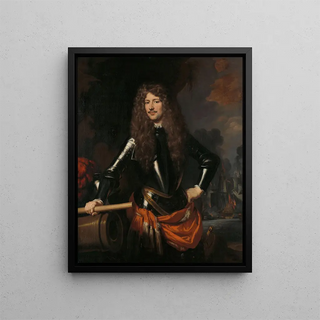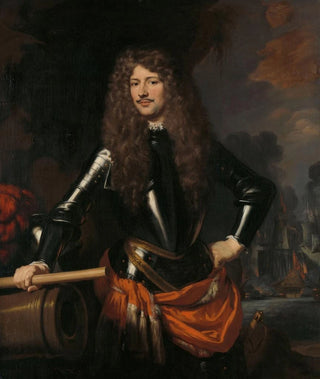Art print | Cornelis Evertsen, Lieutenant-Admiral of Zeeland - Nicolaes Maes Source: Reproduction | Cornelis Evertsen, lieutenant-amiral de Zélande - Nicolaes Maes


View from behind

Frame (optional)
The art print "Cornelis Evertsen, lieutenant-admiral of Zeeland" by Nicolaes Maes is set at a pivotal moment in Dutch art history, where portraiture becomes a privileged means of expression and social representation. Capturing the essence of an influential 17th-century statesman, this piece does more than freeze an image; it evokes a story, an era, a stature. As viewers contemplate this art print, they are transported into a universe where the sea and naval glory blend with the nuances of human personality. Maes's mastery, both in rendering textures and in composition, invites reflection on the nature of power and prestige.
Style and uniqueness of the work
Nicolaes Maes's style is characterized by meticulous attention to detail and skillful use of light. In this art print, the light appears to caress the face of the lieutenant-admiral, highlighting features marked by experience and determination. The colors, rich and nuanced, create an atmosphere that is both solemn and accessible. What sets this work apart is its ability to transcend simple portraiture to become a true narrative painting. Elements of the navy, subtly integrated into the background, recall the maritime context of Evertsen's life, while adding symbolic depth to the composition. Every brushstroke tells a story; every shadow and light evoke emotions, making this art print unforgettable.
The artist and his influence
Nicolaes Maes, a pupil of Rembrandt, successfully integrated his master's legacy while developing his own style. His artistic journey is marked by a significant transition, moving from genre painting to more formal portraits, such as that of Cornelis Evertsen. Maes was able to capture the essence of his subjects, endowing them with dignity and humanity that still resonate today. His influence extends beyond his era, inspiring generations of painters to explore the complexity of human emotions through portraiture. By choosing to depict historical figures, Maes contributes to the construction of

Matte finish

View from behind

Frame (optional)
The art print "Cornelis Evertsen, lieutenant-admiral of Zeeland" by Nicolaes Maes is set at a pivotal moment in Dutch art history, where portraiture becomes a privileged means of expression and social representation. Capturing the essence of an influential 17th-century statesman, this piece does more than freeze an image; it evokes a story, an era, a stature. As viewers contemplate this art print, they are transported into a universe where the sea and naval glory blend with the nuances of human personality. Maes's mastery, both in rendering textures and in composition, invites reflection on the nature of power and prestige.
Style and uniqueness of the work
Nicolaes Maes's style is characterized by meticulous attention to detail and skillful use of light. In this art print, the light appears to caress the face of the lieutenant-admiral, highlighting features marked by experience and determination. The colors, rich and nuanced, create an atmosphere that is both solemn and accessible. What sets this work apart is its ability to transcend simple portraiture to become a true narrative painting. Elements of the navy, subtly integrated into the background, recall the maritime context of Evertsen's life, while adding symbolic depth to the composition. Every brushstroke tells a story; every shadow and light evoke emotions, making this art print unforgettable.
The artist and his influence
Nicolaes Maes, a pupil of Rembrandt, successfully integrated his master's legacy while developing his own style. His artistic journey is marked by a significant transition, moving from genre painting to more formal portraits, such as that of Cornelis Evertsen. Maes was able to capture the essence of his subjects, endowing them with dignity and humanity that still resonate today. His influence extends beyond his era, inspiring generations of painters to explore the complexity of human emotions through portraiture. By choosing to depict historical figures, Maes contributes to the construction of






